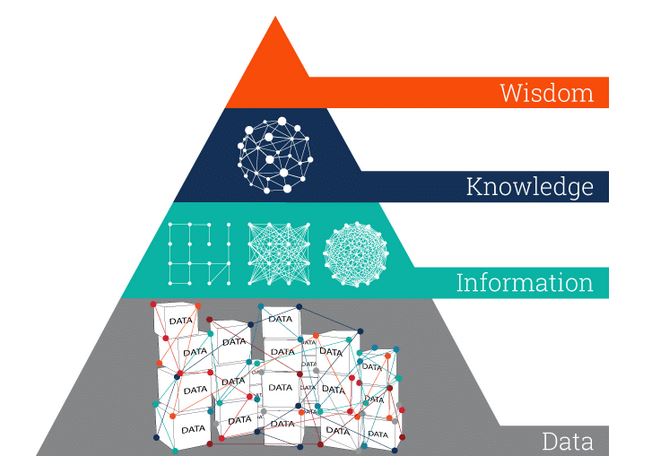We all know that data matters. But for publishers looking to become more data-savvy, it can be hard to know where to start, especially when we are often dealing with qualitative data. Which metrics are important? How do you incorporate data collection and analysis into your workflow? Finding yourself with a glut of data and no real way to interpret or incorporate it isn’t much better than no data at all.
Frameworks for data collection and analysis can help. They provide structuring principles to guide publishers who are developing a data strategy. One that we’ve been thinking about since we attended the Firebrand Community Conference is the DIKW model.
DIKW stands for Data, Information, Knowledge, Wisdom. The pyramid structure represents a process of refining raw data into actionable insight.

Data refers to information in its raw form. This broadest and lowest tier of the pyramid represents the whole glut of information that’s available to you. In this system, data has no context, but is readily available. It needs to be interpreted.
Information begins the interpretation process by putting that information in context. This might mean answering the who, what, when, where, and why’s of the data from the first block of the pyramid.
Knowledge puts the information you have in context. It might link the information you’ve already gained earlier in the pyramid to other pieces of information or take into account trends or events that happened around the same time as the pieces of information were gathered. This block of the pyramid looks at how the information you have fits into a more global view of a project or an industry.
Wisdom, at the top of the pyramid, is what you do with the knowledge you have. Wisdom determines the path forward given the ways you have interpreted the data. Ultimately, when publishers say that they want to be data-driven, they mean that they want to get to this point of the pyramid, where their next steps are guided by data insights.
Let’s see this in action with a famous literary example.
- Data: 031544
- Information: This is a date – March 14, 44 BCE
- Knowledge: There was a prophecy (at least in Shakespeare’s Julius Caesar) to “beware the Ides of March.”
- Wisdom: If you’re Caesar, consider calling in sick to the Senate.
Now, let’s put it in terms of the information available to publishers within their NetGalley accounts.
- Data: 589, 82018, 2304, 011819
- Information: 589 and 2304 are impression counts for two different titles, Title A and Title B. 82018 and 011819 are the dates that each of the titles went live on NetGalley. Title A went live on August 20, 2018 and Title B on January 18, 2019.
- Knowledge: Both titles were listed as Nonfiction (Adult) and Biographies & Memoir in NetGalley. The publisher booked an eblast for Title B that went out to all NetGalley members who are interested in the Nonfiction category.
- Wisdom: By comparing two similar titles that fared differently on NetGalley, we can see two differences immediately. Title A was put on NetGalley in the end of summer when many members are on vacation, meaning that they might be less likely to be at their computer requesting new titles to read. The publisher might consider putting titles up earlier in the summer so that members can read them on vacations, or later in the fall when business-as-usual has resumed. Additionally, we can see that booking an eblast seems to have had a huge effect on impressions, which can help the publisher determine where to best spend ad dollars in the future.
The DIKW paradigm isn’t the end-all, be-all of data-centered decision making. Some critics have pointed out that the pyramid is too rigid and hierarchical. We certainly see their point, and recognize that flexibility is a crucial aspect to successful decision-making.
DIKW is best thought of a starting point – a structure that can be tweaked. It’s a way to begin to think about what data points you as a publisher need to be collecting, what context will help make those data points meaningful, and how you can take that information with you into the future. For publishers who are in the process of asking themselves what it means to be data-driven, the DIKW pyramid is a great place to start.

One thought on “Developing a data strategy with the DIKW Model”